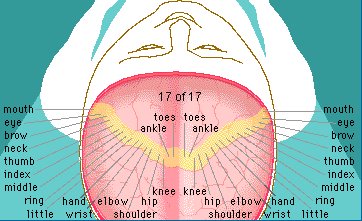In order to keep us alive, the brain uses a set of sensory organs (eyes, ears, nose, tongue, skin) to tell us some of what is going on in the outside world. Remember, we can't hear like a dog, smell like a bear, or see like a hawk. In fact, when compared to the rest of the animal kingdom, human senses seem quite limited.
Our ears hear sound only within a certain range
Our eyes see light in the visual range but not infrared or ultraviolet light
Our perception of touch requires a certain level of pressure
Our sense of smell only helps us if a scent is powerful or nearby
Despite these limitations, our powerful human brains can still integrate the information from all of our different senses and use it to create an internal representation of the external world.
Everything we experience is filtered by our senses. All sensory signals (sound, sight, taste, touch) initiate a cascade of processes in the brain that alter brain structure and function. This process of creating some internal representation of the external world (i.e., information) depends upon the pattern, intensity, and frequency of neuronal activity produced by sensing, processing, and storing signals.
Experience creates a processing template through which all new input is filtered. The more frequently a certain pattern of neural activation occurs, the more indelible the memory becomes. All living organisms have mechanisms to sense and respond to changes in their environments. These mechanisms respond continually and are designed to keep our body's systems in a state of equilibrium or homeostasis.
We have sensory mechanisms to tell the brain what is going on in the internal world of the body. For example, we have special sensory apparatuses that tell the brain the concentration of oxygen in the blood. Other systems sense the concentration of salts (e.g., too much salt causes a sensation of thirst) or gases such as carbon dioxide. These internal sensory mechanisms, like the five senses for the external world, help the brain continuously monitor and act to maintain life.
Process
Once our sensory apparatuses have translated physical or chemical information from the outside (or inside) world into neuronal activity, this set of signals travels up into the brain to be processed. Sensory information from the external environment and the internal environment enters the central nervous system at the level of the brainstem and midbrain.
As this primary sensory input arrives, it is matched against previously stored patterns of activation. If the pattern is unknown, or is associated with previous threat, the brain will activate a set of responses that are designed to help promote survival. (This alarm response is at the heart of the post-traumatic symptoms seen in so many maltreated children.)
http://www.childtraumaacademy.com/amazing_brain/lesson01/page03.html















No comments:
Post a Comment